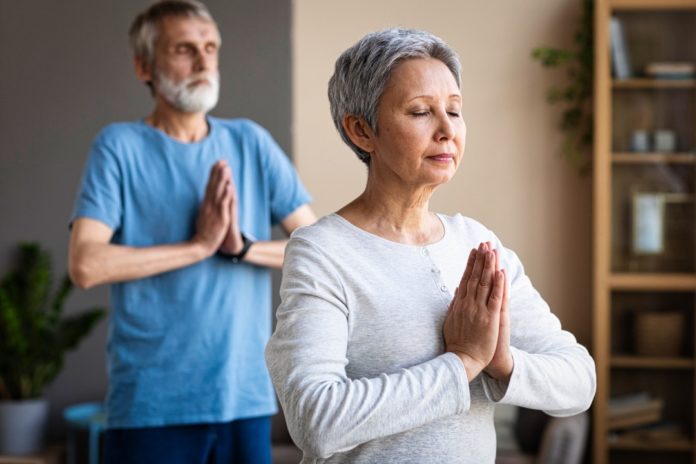Many of us have felt the rejuvenating and empowering effects of yoga, but how do we maintain our practice in a safe and healthy way as we get older? With age comes the inevitable reality of a lifetime of chronic injury, general wear and tear on joints and muscles, and decreased levels of elasticity and tone in the skin. Although the often unpleasant side effects associated with getting older also include stiffness, decreased mobility and reduced strength, they are not necessarily a given. A regular yoga practice in older populations can improve physical function, mental health, pain, flexibility, and balance.
Studies on yoga for aging
A meta-analysis published in the April 2019 issue of the International Journal of Behavioral Nutrition and Physical Activity provides powerful evidence to show the potent benefits of yoga for older yoga practitioners. In the article, researchers examined 22 studies across 10 databases to determine if there were any hard proof that yoga does, in fact, benefit people as they age.
The study inclusion criteria included a focus on adults age 60 and up, with no previous yoga recruitment based on specific health issues. In the studies that were examined the duration of practices ranged from one-seven months long, with individual sessions lasting from 30-90 minutes, practiced 2-3 times per week. Eight styles of yoga were used in the studies. The most popular were Hatha yoga, chair yoga, and Iyengar yoga. Using statistical analysis the researchers compared the results of the studies to other forms of exercise like walking and gentle aerobics, as well as no activity at all.
Yoga improves overall well-being
A wide range of physical improvements was identified, including increased flexibility, greater strength, and improved balance and motor coordination. Participants also exhibited an elevated sense of physical health, mental health, and emotional wellness, when compared to those engaging in other physical exercises, or none at all.
Just as important were the mental improvements which included decreased anxiety and depression, better sleep and an improved sense of overall vitality. This aspect is especially encouraging because, in addition to the purely physical effects of aging, people can be faced with a number of challenging mental and emotional aspects too. These are often brought on by the passing of loved ones, the reality of decreased physical abilities, and possibly also fear of death, although a study published in the Journal of Gerontology notes that in many cases fear of death actually decreases with age.
Essential yoga poses for older practitioners
The most common postures that were used in these yoga for aging programs were Cat and Cow/Dog pose, Tree, Triangle, Seated twist, Mountain pose, Warrior I, Cobra, Chair pose, Eagle, Locust, Downward Facing Dog, Wind Relieving pose, Child’s pose, Standing Hand to Foot pose, and Cow Face pose. Modifications and the use of props, especially blocks, are highly recommended when practicing these poses with populations over the age of 60. In this age group, it is especially important to modify or skip yoga postures where there is pain or discomfort in the joints.
Other research on yoga for healthy aging
The results of the study also reinforce other research being done on the benefits of yoga for overall health. One interesting piece published in the June 2016 Future of Science OA explores the anti-aging effects of pranayama practice, noting that, although more control studies are needed, it appears that there is a positive correlation between yoga and decreased aging effects on the skin, due largely to the antioxidant and cleansing effects of certain poses and breath practices.
Yoga practices beneficial for aging
Yoga’s multi-faceted approach to wellness focuses on the mind/body relationship to health and the interconnectedness of all aspects of a person’s life, as they relate to overall health. This ancient practice and way of life incorporates asana (physical poses) pranayama (breathwork) and meditation, allowing people to find the best combination to fit their needs at any given time. While it is, of course, smart and safe to meet ourselves where we are in terms of our practice abilities, it is also important to not allow the perceived limitations of an aging body or fear of pain or reduced ability to stand in our way.
Find your own path
Lifelong student and teacher BKS Iyengar maintained his daily yoga practice well into his 90’s. In his words, “Often people think that at the old age they should do dhyana (meditation) or japa (repetition of mantras) instead of asana and pranayama practice. I am not that type of a sadhaka (practitioner) to take shelter under the garb of old age. I will not run away from my practice because of the fear complex of old age…Because of age, I have increased timings in my practices. Mind and body want to give way. I daily charge my body and mind to stand with will power so that I do not surrender to the weakness of my body and mind.”
There is no “one size fits all” formula for yoga, and no matter our age we are continually faced with the challenge of simply showing up to the mat, despite the physical or mental resistance that may be present. A regular yoga practice provides a valuable framework for overall health, with many modifications available to us, making it an ideal lifelong practice that evolves with us as we age, change and grow.
We recommend working with a yoga teacher with a Yoga for Healthy Aging certification or similar training and who has experience working with older yoga students. There are also several excellent books you can reference, like Yoga for Healthy Aging, Yoga to Stay Young, and Stay Young With Yoga.


























